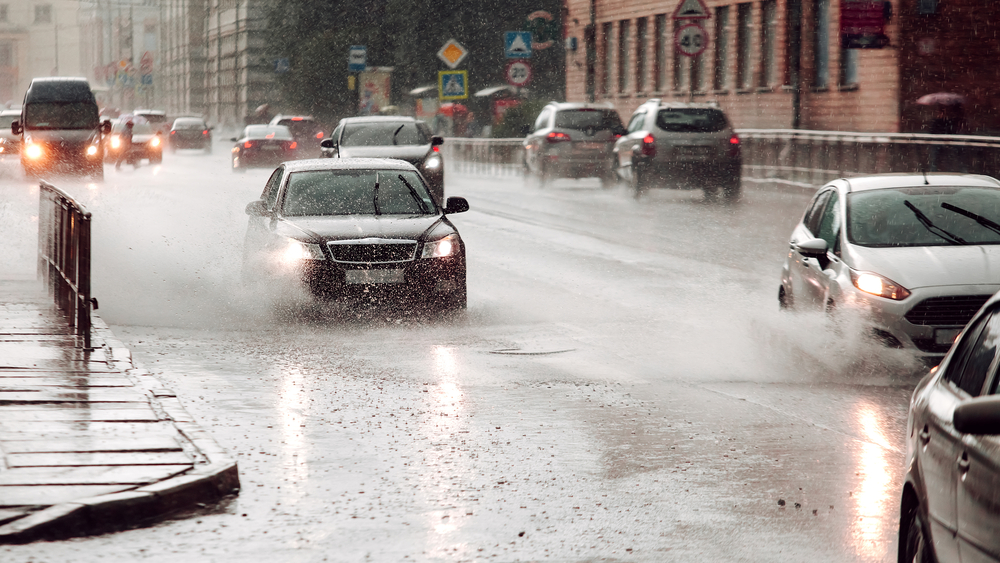Driving in heavy rain presents a unique set of challenges and dangers that many drivers in coastal regions like Myrtle Beach or Charleston encounter regularly. Slick roads, reduced visibility, and the possibility of hydroplaning make it more important than ever to stay cautious behind the wheel. Whether you’re commuting in Charlotte or taking a scenic drive near John’s Island, knowing how to navigate treacherous weather conditions is crucial for your safety.
This article highlights six essential tips for driving in heavy rain. By following these guidelines, you can reduce your risk of accidents, stay in control, and arrive at your destination safely, even when the weather takes a turn for the worse.
1. Slow Down and Increase Following Distance
When rain begins to fall, the first thing you should do is slow down. Wet roads can significantly reduce the traction between your tires and the asphalt, making it harder to stop or control your vehicle. Driving at high speeds during heavy rain increases the risk of hydroplaning, which happens when your tires lose contact with the road and skid across the water surface. Hydroplaning can cause you to lose control of your vehicle, leading to dangerous accidents.
In addition to reducing your speed, increase your following distance. Tailgating during heavy rain is a recipe for disaster. Your car will take longer to stop on wet roads, so giving yourself extra space between your vehicle and the car in front of you allows more time to react if they suddenly brake.
For instance, while driving through Wilmington, where heavy rain is common during storms, leaving a larger gap between vehicles can be the difference between a close call and a collision.
2. Turn on Your Headlights (But Avoid High Beams)
Visibility is often greatly reduced during heavy rain, and it’s crucial to make sure you can see the road and that others can see you. Turning on your headlights in the rain is a simple yet vital step in staying safe. In many states, including South Carolina, it’s a legal requirement to turn on your headlights when it’s raining, even during the day.
However, avoid using your high beams. High beams can reflect off the rain, creating a glare that makes it even harder for you to see. Instead, stick to your low beams, which help you see the road more clearly without blinding other drivers. If your vehicle has fog lights, these can also be useful for increasing visibility during particularly heavy downpours or foggy conditions.
For example, if you’re driving along the coast near John’s Island during a rainstorm, using your low-beam headlights ensures you have a clear view of the road ahead and can spot any potential hazards.
3. Avoid Standing Water and Watch for Hydroplaning
Standing water is one of the biggest dangers you can face while driving in heavy rain. Puddles and flooded roads can cause your vehicle to hydroplane, which happens when a layer of water builds up between your tires and the road surface, causing a loss of traction. When your vehicle hydroplanes, you lose control of steering, braking, and accelerating.
To avoid hydroplaning, always steer clear of large puddles or areas where water has accumulated. If you do start to hydroplane, resist the urge to brake hard or turn the wheel sharply. Instead, ease off the gas pedal and keep the steering wheel straight until your tires regain traction.
If you’re driving through Greenville during a rainstorm, be particularly cautious on bridges and overpasses, as these areas tend to accumulate water more quickly, increasing the chances of hydroplaning.
4. Ensure Your Wipers and Tires Are in Good Condition
One of the most important factors in driving safely in the rain is having a clear view of the road. If your windshield wipers are old or worn out, they won’t be able to effectively clear the rain from your windshield, leading to poor visibility. Regularly check and replace your windshield wipers to ensure they’re in good condition. If they leave streaks or don’t clear the windshield effectively, it’s time for a new set.
Additionally, your tires play a significant role in how well your car handles on wet roads. Bald or worn tires reduce your vehicle’s grip on the road, making it more likely for you to skid or hydroplane. Check the tread depth of your tires regularly and replace them if necessary. Tires with good tread provide better traction and help channel water away from the tire, improving your control during wet conditions.
If you’re driving in Concord, where rainy days can lead to slick roads, having properly maintained wipers and tires can make all the difference in preventing accidents.
5. Use Cruise Control Wisely (Or Not at All)
Cruise control is a helpful feature for long drives, but it can be dangerous to use during heavy rain. Cruise control maintains a constant speed, which can cause issues if your vehicle starts to hydroplane. If your car skids on a wet surface while using cruise control, the system may attempt to accelerate or brake, which could lead to a loss of control.
Instead, it’s better to manually control your speed in the rain. This way, you can adjust your speed more responsively based on road conditions and any potential hazards you encounter.
For example, if you’re driving on the highway near Charleston during a rainstorm, disabling cruise control allows you to react quickly to changing conditions, such as sudden stops or water on the road.
6. Stay Alert and Avoid Distractions
Driving in the rain requires your full attention. Distractions, like using your phone, adjusting the radio, or eating while driving, can significantly increase the chances of an accident in poor weather conditions. In heavy rain, the roads become unpredictable, and hazards like standing water, disabled vehicles, or debris may appear without warning.
Keep both hands on the wheel and your eyes on the road at all times. If you need to adjust your GPS or make a phone call, pull over to a safe location. Additionally, avoid using your phone, as texting or even glancing at it can take your attention away from the road at a time when you need it the most.
Whether you’re driving in Myrtle Beach during a summer storm or navigating a downpour in Wilmington, staying alert and focused will help you react to hazards quickly and keep yourself and others safe.
Driving in heavy rain can be nerve-wracking, but by following these six safety tips, you can stay in control and reduce your risk of accidents. Slowing down, using your headlights, avoiding standing water, and maintaining your vehicle are all simple steps that can have a significant impact on your safety.
At Beach Insurance LLC, we understand that even the most cautious drivers can encounter unexpected challenges on the road. That’s why we offer comprehensive auto insurance to protect you in all conditions. Whether you’re driving in Charleston, Charlotte, or Wilmington, we’ve got you covered. Call us today at 843-718-0075 to learn more about how we can help keep you safe on the road.







Leave A Comment